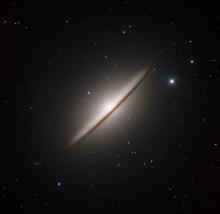Listen to today's episode of StarDate on the web the same day it airs in high-quality streaming audio without any extra ads or announcements. Choose a $8 one-month pass, or listen every day for a year for just $30.
You are here
Dark Heart
Five years ago, astronomers at McDonald Observatory searched for dark matter in a small companion galaxy of the Milky Way. They found darkness all right, but not much dark matter. Instead, they found a black hole that’s almost as big as the one at the heart of the Milky Way.
Leo I is more than 800,000 light-years away. That makes it one of the Milky Way’s most-distant satellite galaxies. And it’s tiny: just one or two percent the width of the Milky Way, and about one fifty-thousandth of the Milky Way’s mass.
Such galaxies are common, though, and many of them appear to contain a lot of dark matter — matter that we can’t see, but that exerts a gravitational pull on the visible matter around it. So astronomers from Texas and Germany examined Leo I to plot its dark matter.
They used a telescope at McDonald Observatory to measure the motions of stars. The way the stars move reveals how much matter is pulling the stars, and how the matter is distributed.
The observations revealed a compact but dark source at the galaxy’s heart — a black hole. It’s 3.3 million times the mass of the Sun — three-quarters the mass of the black hole in the Milky Way. It hints that even bigger black holes grow from the mergers of galaxies like Leo I — more darkness from small galaxies.
Leo I is just a whisker away from Regulus, the brightest star of Leo, the lion. Regulus is due east as night falls, and springs high across the south during the night.
Script by Damond Benningfield






